♠ Article Library ♦ Board Gallery
Over the past several months my mail has included an increasing number of requests for information about ivory cribbage boards as well as appraisals for both ivory and other types of boards. I want to clarify my position on both subjects. I am not an expert on ivory and find it difficult, at best, to tell if a cribbage board is genuine ivory or not. The pin test, which has been referenced in many publications on ivory, should be administered by an expert on the subject, if at all! My files, however, now contain many photos and written documentation about authentic and reproduction ivory cribbage boards, allowing me a limited capability to provide a qualified responses to some of your questions.
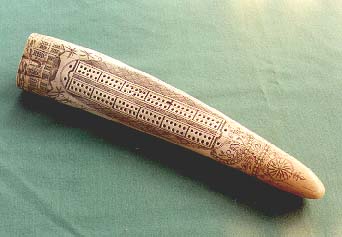
Let's take as an example a cribbage board which was recently auctioned on eBay and originally advertised as authentic ivory. The board is a beautiful specimen, and it has fooled quite a few people who have purchased reproductions of it. In my archives, I now have several sets of photos of the identical board, right down to the age cracks, that have been sent to me by cribbage board collectors requesting information. After doing a close comparison of the eBay board with my photos, I took it upon myself to contact the seller and give her the information that I had about the cribbage board. She had also been contacted by two other people, and based on the information given her by all of us, she posted an addendum to the auction which notified would-be bidders that the board was indeed a reproduction. I would not have contacted her if I hadn't had overwhelming evidence of the board's abundant quantities.
In response to the many folks who have written requesting appraisals of their cribbage boards: an appraiser of collectibles normally charges a fee for the expertise which is being presented. My role in contributing these articles on cribbage board collecting to the ACC is to enhance the public's awareness of another facet of the game of cribbage. If I were to start appraising, and charging for the appraisals, my role would become somewhat desecrated! Please respect my position on this aspect of collecting, but continue to pick my brain about your boards and their histories!
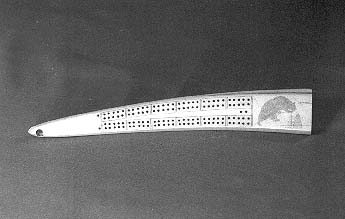
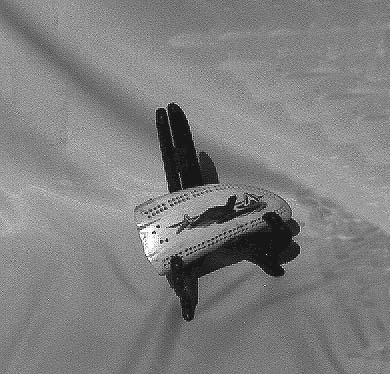
Alaskan Walrus Tooth (1967)
The wonderful art of carving and scrimshawing walrus tusks, teeth and other ivory or bone artifacts by the Eskimos of Alaska is legendary, to say the least. Much information is documented about their carvings especially those from Nunivak Island, the Yupik carvers from St. Lawrence Island, as well as the carvers of the early 20th Century such as Happy Jack (Angokwazhuk) from Cape Nome. Most local libraries and book stores can provide books and articles on the history of the Alaskan and Eskimo ivories, such as those written by Dorothy Jean Ray, if you take the opportunity to look. Many of these books and articles will also provide information about the regulations regarding the sale of ivory, which were established in the early 1970's by the Convention on the International Trade in Endangered Species (sponsored by the United Nations).
In spite of my extensive collection of photos, none of the scrimshawed cribbage boards shown have been documented as having originated at the hands of the whalers of the late 19th Century. There are, however, many fine examples of cribbage boards to be found in the various whaling museums, including the New Bedford (MA) Whaling Museum and the Peabody Museum of Salem (MA). Many of the cribbage boards located in whaling museums have been reproduced, and some of them are so realistic that they often fool even the experts! Bette's Cribb, my little mail order catalog for cribbage novelties, has contained several of the "Save the Whale" and other artists' scrimshawed cribbage board reproductions. The first board pictured in this article is probably a reproduction of a whaler's scrimshaw. History has it that the whalers, who spent long, lonely months and years away from their families, took to carving and scrimshawing the bones and ivories of the whales to help pass the time.
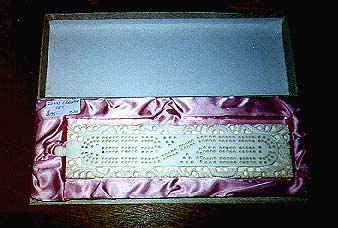
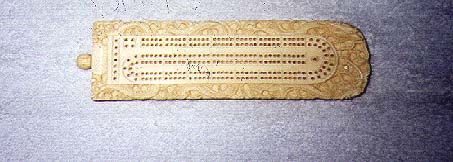
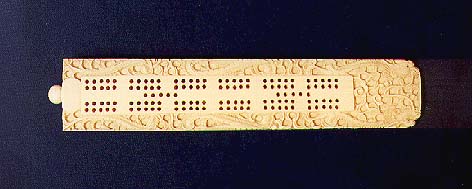
Carved elephant ivory from Japan and Hong Kong became very popular right after WWII, as the tradesmen rushed to recover from the losses of the war. With American servicemen and officials very much visible and anxious to take home souvenirs, the market for these products soon flourished. Many of the photos that I have received are of carved cribbage boards that servicemen purchased NEW during that time period. The carvings are usually of dragons or floral, and the boards are approximately 7 inches in length, graduating in thickness from one end to the other. Most have a screw-in cover at one end to enclose the pegs. These boards were often enclosed in satin or velvet-lined boxes, which enhanced the rich patina of the elephant ivory. Most, if not all, contained labels identifying the pieces as ivory, as well as the origin of the product. At least three of the boxes are stamped with the name and address of the distributors - Hang On Factory (Hong Kong), and Haiwa Trading Co., Ltd. (Tokyo). These boards, according to recent purchasers, have cost them between $100 and $150 (that is their information, not an appraisal by me)! The two boards that I own cost slightly less, but were not boxed.
The marketplace contains several reputable companies which specialize in the sale of unfinished ivory, horn, antler and bone specimens for craftsmen who wish to create their own products. These companies authenticate the products that they sell, and they offer books which will make the buyer more knowledgeable. One such company is the Boone Trading Co., Inc., which is located in the State of Washington.
In summary, the ivories make for a wonderful and eclectic collection, whether they be carved, scrimshawed, or plain. The expert will know whether the board is authentic or not. The novice will need to seek assistance in that determination, or (s)he might well become the victim of misjudgment!
This concludes the information which I have gathered about ivory cribbage boards. I know little more than what is written here, and as I said earlier, I am no expert in determining what is authentic or reproduction. Please feel free to enhance my knowledge with your photos and any information that you have about the board. With your input, I may be able to prevent someone else from making a serious blunder with a purchase! A special thanks to collectors Michael Palicia, Ethel Frost and Tom O'Gara for providing photos to the CBCS, which have been included in this article.